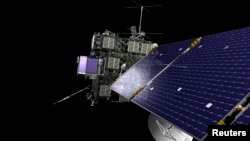Scientists using Europe's comet-orbiting Rosetta spacecraft have discovered that the complicated ancient body is coated with surprisingly simple organic molecules and surrounded by a changing cloud of gases, according to research released Thursday.
After a 10-year journey, Rosetta reached Comet 67P/Churyumov-Gerasimenko in August and put itself into orbit for an unprecedented long-term study. In November, it released a piggyback-riding spacecraft, which descended to the comet's surface for a series of independent studies.
Comets are believed to be frozen leftovers from the formation of the planets some 4.6 billion years ago. The Rosetta mission is intended to shed light on the solar system's early days by studying one of its pristine comet remnants.
Results from the Philae spacecraft experiments are pending, but scientists Thursday released seven papers in the journal Science that detailed Rosetta's findings during its first two months around 67P.
The teams found the comet's body, which is about 100 million times more massive than the International Space Station, is covered in dunes and ripples, with little detectable water ice on its surface and generous quantities of hydrocarbons.
Scientists said they expected to find more complex carbon-containing molecules but had found mostly simple hydrocarbons, which raised questions about how organic compounds formed and spread through the solar system.
Scientists must first figure out how the comet has changed over time, details of which will emerge as 67P travels toward the sun and heats up, developing a coma, or a visible atmosphere, and a tail.
Already, researchers have discovered wide variations in the gases being released from the nucleus, the comet's body. The changes in the quantities of the gases appear to be tied to whether a section of the rotating nucleus, which is made of dust, rock and frozen gas, is in daylight or darkness.
Over time, seasonal effects also may be discovered, said Rosetta scientist Myrtha Hassig of the Southwest Research Institute in San Antonio, Texas.
Ultimately, the studies will have an impact on scientists' understanding of comet formation and evolution.
"We're taught that comets are made mostly of water ice. For this comet, the coma sometimes contains much more carbon dioxide than water vapor," said Rosetta scientist Stephen Fuselier, also with the Southwest Research Institute.
Overall, the comet's nucleus seems to be fluffier and more porous than computer models had predicted. Scientists also are working to figure out whether 67P, which is shaped like a rubber duck, actually was two smaller comets that melded together.
Rosetta will continue to fly around the comet as it moves toward and then away from the sun. The closest approach, about 116 million miles (186 million kilometers) away from the sun, will be on Aug. 13.







